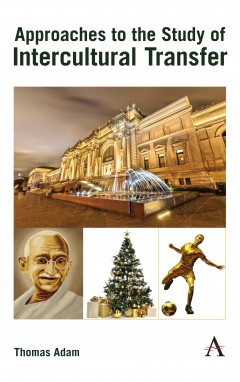Approaches to the Study of Intercultural Transfer
By Thomas Adam
Other Formats Available:
- About This Book
- Reviews
- Author Information
- Series
- Table of Contents
- Links
- Podcasts
About This Book
“Approaches to the Study of Intercultural Transfer” presents a collection of compelling case studies in the area of social reform, museums, philanthropy, football, nonviolent resistance and holiday rituals such as Christmas that demonstrate key mechanisms of intercultural transfers. Each chapter provides the application of the intercultural transfer studies paradigm to a specific and distinct historical phenomenon. These chapters not only illustrate the presence or even the depth and frequency of intercultural transfer, but they also reveal specific aspects of the intercultural transfer of phenomena, the role of agents of intercultural transfer and the transformations of ideas transferred between cultures thereby, contributing to our understanding of the mechanisms of intercultural transfers.
The transfers explored in this volume provide for a narrative of an interconnected world in which societies and cultures exchanged ideas and objects over long distances connecting places and spaces across the globe and contributing to the creation of distinct local cultures and societies. Ideas about social reform and customs such as the Christmas tree were transferred across political and geographic borders. In the process, they were modified to fit into the receiving society. They lost some of their meaning and received new meaning. The Pagan symbol of the Christmas tree was Christianized through its transfer from cities such as Dresden to cities such as Boston.
Concepts such as Gandhi’s nonviolent resistance appealed to many Western observers who considered peaceful and rational conflict solution in the aftermath of World War I as essential to the survival of humankind. The appeal of nonviolent resistance did not result in a full grasp of such phenomena. Western observers misunderstood and mistranslated Satyagraha with passive resistance. Such modifications reveal the nature of intercultural transfer. In this process, the power of adopting a new idea rests with the receiving society. The giving society has little influence over the transfer process and loses control over the transfer fairly early. This contributed to the conundrum of the modern world which, in spite of the multitude of such transfers, became not only more similar but also more dissimilar.
Reviews
“This collection offers a practical introduction to the theory, methodology and implications of intercultural history. The book’s well-researched, clearly argued case studies bring together a mass of material and references that will be much appreciated by researchers focused on social policy, philanthropy, cultural institutions and popular culture in transnational context.”
—Alan Lessoff, University Professor of History, Illinois State University, USA
“Thomas Adam’s new book provides us with a rich and stimulating collection of essays. The many different examples of cross-national and cross-Atlantic exchanges make the book interesting to a wide range of readers, while also serving as a model of how to design similar case studies. He argues convincingly that transfer did not make the world more homogeneous, but that it strengthened its diversity.”
—Axel Körner, Professor of Modern History, and Director, UCL Centre for Transnational History, University College London
The analysis of the resemantizations that led to the creation of an American culture constitutes a promising new field of inquiry in the wide framework of transcultural transfer. Thomas Adam's book is an important milestone in this regard. — Michel Espagne: Rezension zu: Adam, Thomas: T. Adam: Approaches to the Study of Intercultural Transfer London 2020. ISBN 9781785271656, in: Connections. A Journal for Historians and Area Specialists, 26.03.2021, <www.connections.clio-online.net/publicationreview/id/reb-93915>
Author Information
Thomas Adam is professor of transnational history at the University of Texas at Arlington, USA. The editor of the Yearbook of Transnational History, he has edited and published more than 25 books and specializes in the study of intercultural transfer and philanthropy. Among Adam’s most recent publications are Transnational Philanthropy: The Mond Family’s Support for Public Institutions in Western Europe from 1890 to 1938 (2016); Philanthropy, Civil Society, and the State in German History, 1815–1989 (2016); and Intercultural Transfers and the Making of the Modern World, 1800–2000 (2012).
Series
Anthem Intercultural Transfer Studies
Table of Contents
Introduction; 1. New Ways to Write the History of Western Europe and the United States: The Concept of Intercultural Transfer; 2. Social Housing Reform and Intercultural Transfer in the Transatlantic World before World War I; 3. Cultural Excursions: The Transnational Transfer of Museums in the Transatlantic World; 4. The Intercultural Transfer of Football: The Contexts of Germany and Argentina; 5. Interreligious and Intercultural Transfers of the Tradition of Philanthropy; 6. Change through Nonviolence: The Rationalization of Conflict Solution; 7. From “Weihnachten” to Christmas: The Invention of a Modern Holiday Ritual and Its Transfer from Germany to England and the United States; Index.
Links
Stay Updated
Information
Latest Tweets



